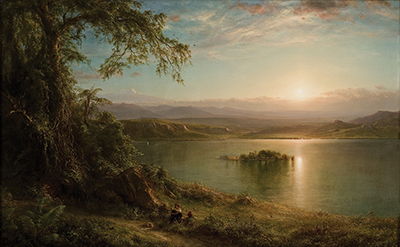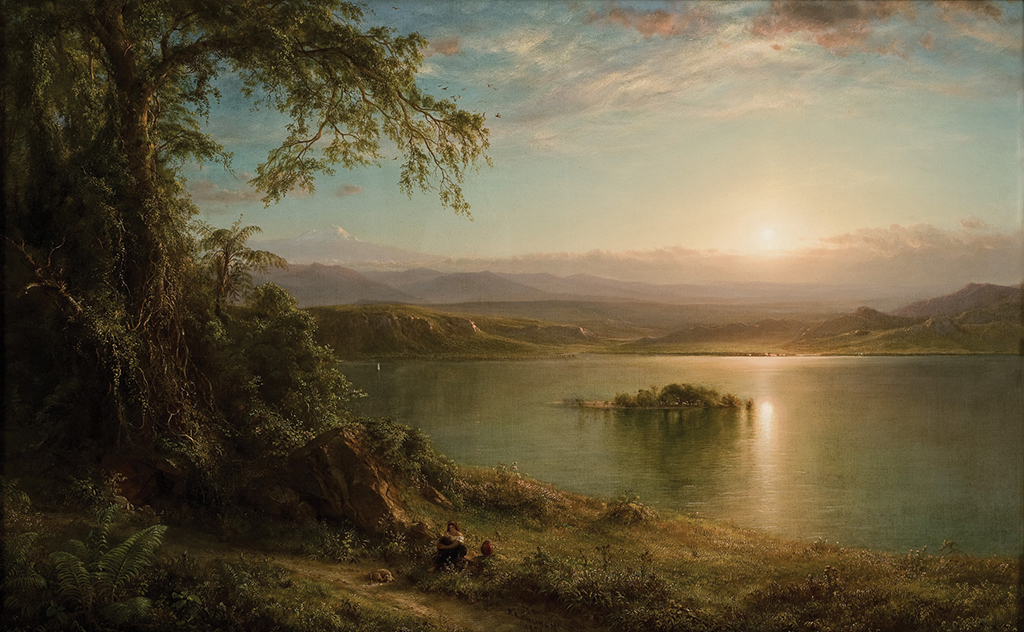 Buy Art Prints Now
Buy Art Prints Nowfrom Amazon
* As an Amazon Associate, and partner with Google Adsense and Ezoic, I earn from qualifying purchases.
Frederic Edwin Church's mastery of landscapes comes to the fore in his painting Twilight in the Tropics which depicts his transcendent use of colour, light, composition and scientific approach to detail.
The scene is set in a luxuriant paradise depicting a partial view of a serene lake reflecting the splendour of the moon in full brilliance. The surrounding clouds seem to part way for Luna's grand journey into the night sky from the netherworld as the trees and surrounding brush on the ground pay homage. Painted in 1874 Twilight in the Tropics communicates vivid insight into light and texture to art lovers both young and old while Church’s oil techniques illustrate his dominance in building up layers of colours that move seamlessly from darker to lighter hues to achieve a smooth, glossy finish and embodiment of form.
Church's muse for Twilight in the Tropics is inspired by the vast South American tropics whose terrain is synonymous with thick rainforest trees, grasslands, water masses and palm tree clusters. Church's creativeness was achieved in the course of two trips taken to Ecuador in the spring of 1853 and 1857.
Church's Influences
Church's Protestant upbringing and tutelage while attending the Hudson River School art movement play a great role in influencing his style and themes. Hudson River School landscapes often captured the wild and unsettled American frontiers of the time while Church's depictions tended more towards her grandeur, majesty and splendour while celebrating her inherent optimism. Church was heavily influenced by German naturalist, explorer and scientist Alexander von Humboldt (1769-1859) whose youthful penchant for collecting and labelling shells, plants and insects paved way for the field of biogeography. Alexander’s work taught Church about the harmonious unity of the universe as one interacting entity.
The works of English art patron and critic John Ruskin (1819-1900) were another major influence on Church, Ruskin being a highly influential social thinker and philanthropist who created detailed sketches of landscapes, birds, plants, rocks and architectural structures and ornamentation. According to Ruskin it was "the imperative duty of the landscape painter to descend to the lowest details with undiminished attention” and to render in each work both industry and precision.
Preparation
Travel was a constant part of Church's life as he sought out precise themes and locations to put to canvas. For Twilight in the Tropics his inspiration was drawn from his travels to Quinto and the Andes in South America, the world's longest continental mountain range with its dramatically different landscapes. He also looked back to his culture and experiences while growing up during the Romantic era (1800-1850), a period whose artists depicted nature in idealised scenes weighed with emphasis on nature’s splendour and abundance.
In conclusion, although Frederic Edwin Church was not primarily a luminist artist his paintings continue to influence the genre through the use of non-diffuse light, concealed brushstrokes that hide the painter's personality and dramatic light effects in his composites, all the while preserving a sense of ageless, emotional intimacy.




